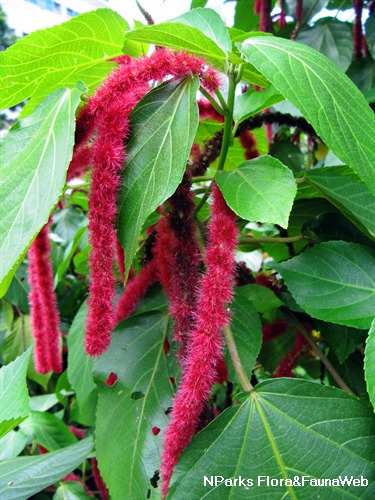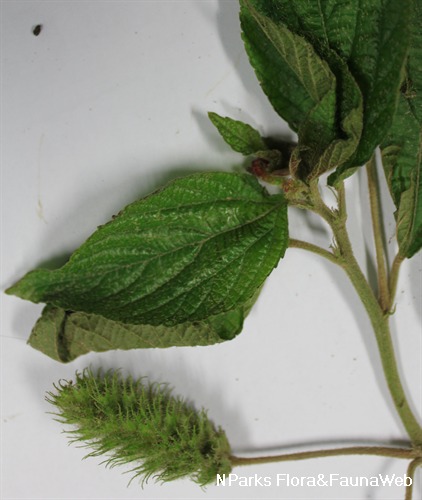
Back
Acalypha hispida Burm.f.
| Family Name: | Euphorbiaceae |
| Synonyms: | Acalypha sanderi |
| Common Name: | Chenille Plant, Red Hot Cat's Tail, Red Cattail, Ekor Kuching, Buntut Kucing, Cat's Tail |
Chenille Plant (Acalypha hispida) is a tropical shrub that produces soft and furry red pendulous flowers hanging down from the leaf axils, resembling strands of yarn or cat's tail that can be as long as 45 cm! It is easy to grow to a large shrub but can be maintained as a small plant by regular pruning, best planted on the ground as accent plant or grown in elevated containers.
Name
Classifications and Characteristics
| Plant Division | Angiosperms (Flowering Seed Plants) |
|---|---|
| Plant Growth Form | Shrub |
| Lifespan (in Singapore) | Semi-Annual / Annual-Like |
| Mode of Nutrition | Autotrophic |
| Plant Shape | Shrubby, Open |
| Maximum Height | 1.5 m to 4.5 m |
| Maximum Plant Spread / Crown Width | 1 m to 2.5 m |
Biogeography
| Native Distribution | Malesia and New Guinea |
|---|---|
| Native Habitat | Terrestrial |
| Preferred Climate Zone | Tropical |
| Local Conservation Status | Non-native (Spontaneous (Casual)) |
Description and Ethnobotany
| Growth Form | Erect, rough textured shrub which is able to grow up to about 1.5 - 3.5 m tall and 1 - 2 m wide. |
|---|---|
| Foliage | Simple, alternate leaves measuring about 10 - 20 cm long and 7 - 10 cm wide. |
| Stems | Woody stems |
| Flowers | Male and female red flowers on separate plants, clustered in catkins and measuring up to 40 cm long. |
| Etymology | Genus name Acalypha comes from the Greek word akelpe, which means unpleasant to touch. |
Landscaping Features
| Desirable Plant Features | Ornamental Flowers, Ornamental Foliage |
|---|---|
| Landscape Uses | Parks & Gardens, Small Gardens, Container Planting, Suitable for Hanging Baskets |
| Usage Hazard - Cons | Toxic Upon Ingestion |
Fauna, Pollination and Dispersal
| Pollination Method(s) | Abiotic (Wind), Biotic (Fauna) (Insects (Bee)) |
|---|---|
| Seed or Spore Dispersal | Abiotic (Wind) |
Plant Care and Propagation
| Light Preference | Semi-Shade, Full Sun |
|---|---|
| Water Preference | Lots of Water, Moderate Water |
| Plant Growth Rate | Moderate |
| Rootzone Tolerance | Moist Soils, Well-Drained Soils, Fertile Loamy Soils |
| Soil pH Range From | 6 |
| Soil pH Range To | 8 |
| Transplanting Tolerance | Moderate |
| Maintenance Requirements | Moderate |
| Pruning | Can be pruned periodically to control its size and make the plant bushier. |
| Potential Problems | Spider mites, mealy bugs and scale insects may be a problem. |
| Propagation Method | Stem Cutting, Leaf Cutting |
| Planting Distance | 1 m to 2 m |
Foliar
| Foliage Retention | Evergreen |
|---|---|
| Mature Foliage Colour(s) | Green |
| Mature Foliage Texture(s) | Smooth |
| Prominent Young Flush Colour(s) | Green |
| Young Flush Texture(s) | Smooth |
| Foliar Type | Simple / Unifoliate |
| Foliar Arrangement Along Stem | Alternate |
| Foliar Attachment to Stem | Petiolate |
| Foliar Shape(s) | Non-Palm Foliage (Ovate, Oval) |
| Foliar Venation | Pinnate / Net |
| Foliar Margin | Serrate / Toothed |
| Foliar Apex - Tip | Acuminate |
| Foliar Base | Cordate |
| Leaf Area Index (LAI) for Green Plot Ratio | 4.5 (Shrub & Groundcover - Dicot) |
Floral (Angiosperm)
| Flower & Plant Sexuality | Unisexual Flowers , Dioecious |
| Flower Colour(s) | Red |
|---|
| Flower Texture(s) | Velvety / Furry / Tomentose |
| Flower Grouping | Cluster / Inflorescence |
| Flower Location | Axillary |
| Flower Symmetry | Radial |
| Inflorescence Type | Catkin |
| Flowering Period | Free-Flowering |
| Flowering Habit | Polycarpic |
Image Repository
Others
| Master ID | 290 |
|---|---|
| Species ID | 1586 |
| Flora Disclaimer | The information in this website has been compiled from reliable sources, such as reference works on medicinal plants. It is not a substitute for medical advice or treatment and NParks does not purport to provide any medical advice. Readers should always consult his/her physician before using or consuming a plant for medicinal purposes. |








_pauline_tay.jpg)
